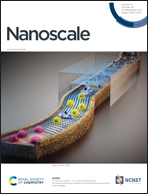Surface morphology controls water dissociation on hydrated IrO2 nanoparticles†
Abstract
Iridium oxide is a highly efficient catalyst for the oxygen evolution reaction, whose large-scale application requires decreasing the metal content. This is achieved using small nanoparticles. The knowledge of the water–IrO2 nanoparticle interface is of high importance to understand the IrO2 behavior as electrocatalyst in aqueous solutions. In this contribution, DFT (PBE-D2) calculations and AIMD simulations on IrO2 nanoparticle models of different sizes ((IrO2)33 and (IrO2)115) are performed. Results show that two key factors determine the H2O adsorption energy and the preferred adsorption structure (molecular or dissociated water): metal coordination and hydrogen bonding with oxygen bridge atoms of the IrO2 surface. Regarding metal coordination, and since the tetragonal distortion existing in IrO2 is retained on the nanoparticle models, the adsorption at iridium axial vacant sites implies stronger Ir–H2O interactions, which favors water dissociation. In contrast, Ir–H2O interaction at equatorial vacant sites is weaker and thus the relative stability of molecular and dissociated forms becomes similar. Hydrogen bonding increases adsorption energy and favors water dissociation. Thus, tip and corner sites of the nanoparticle, with no oxygen bridge atoms nearby, exhibit the smallest adsorption energies and a preference for the molecular form. Overall, the presence of rather isolated tip and corner sites in the nanoparticle leads to lower adsorption energies and a smaller degree of water dissociation when compared with extended surfaces.



 Please wait while we load your content...
Please wait while we load your content...